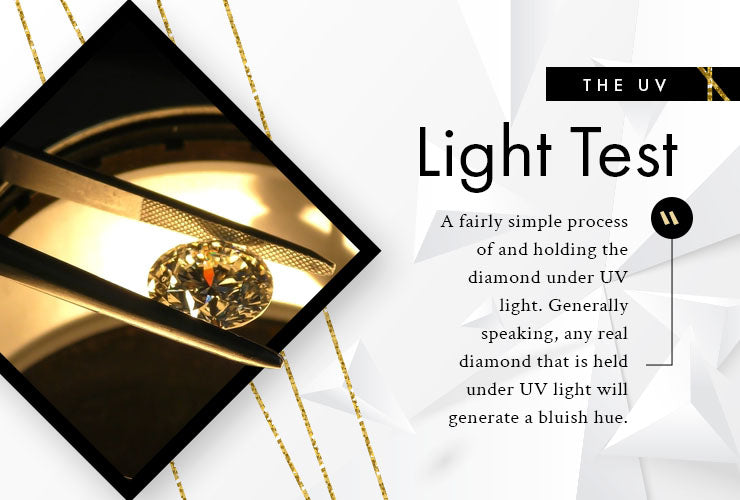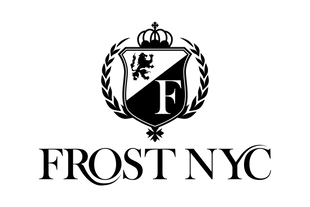How to Tell If Diamonds Are Real: A Full Guide

When it comes to diamonds, there are a lot of myths and misconceptions floating around. Many people believe that if a diamond is too affordable, then it probably isn't real. Others think that true diamonds must be bought from a jeweler and that you can't find them at pawn shops or other secondhand stores. And still, others believe that you can tell if a diamond is real just with a thorough inspection.
The truth is, determining whether a diamond is real can be tricky — especially if you have absolutely no idea what you're looking for. At Frost NYC, we know that understanding the value of diamonds or any piece of jewelry (from gold chains for men to earrings and more) is essential to confidently enhance your style.
In this guide, we'll school you on how to spot fake diamonds as well as how to tell the difference between natural and synthetic diamonds, which are gaining momentum across the jewelry markets right now. We'll also cover some of the most common ways to test for authenticity, so you can feel confident in the diamonds you buy — or sell.
Important note: Just remember that these are fairly standard guidelines. When it comes to commissioning real appraisals, we recommend getting a referral to a trusted professional.
Check the Paperwork
The best way to determine if a diamond is real is by getting it appraised by an expert gemologist. There are some simple guidelines you can follow, however, to give you more confidence in your diamonds.
First things first — if the diamond doesn't come with a certified identification card that includes the seller's information as well as all of the details about the individual diamond (size, cut, color and clarity), then it's most likely fake. In addition to this documentation, keep an eye out for any kind of irregularities in the shape. Diamonds should be symmetrical and free from blemishes.

Understand the Four Cs
Once you've ruled out any obvious signs that the diamond may be fake in your gold grills or necklace, you can begin evaluating its quality based on what's known as the four Cs: carat, cut, clarity and color.
Browse Gold GrillsThe Eye Test: Color
In terms of color, take note of how the diamond appears. Natural diamonds should be transparent and free of any tints or hues, whereas fake diamonds often have yellowish or brownish overtones. Additionally, the hue of a diamond can depend on its cut — so make sure you're comparing apples to apples. Also, not all diamonds are crystal clear. So if there is some coloring, that may not discount it. To that point, off-color diamonds likely aren't as expensive or in demand.
A Sense of Clarity
In terms of clarity, natural diamonds will have slight imperfections that are hardly noticeable to the naked eye. If the stone looks too perfect, it could be plastic (or even worse!). Another telltale sign is if you notice any kind of bubbles in the diamond, which indicate that it isn't real.
Carat Weight
Carat weight is one of the most important factors to evaluate when determining whether or not a diamond is real. Natural diamonds are typically very dense and heavy, whereas fake diamonds will be significantly lighter in weight.

This is one of the easiest tests you can do on your own — just pick up the diamond with your fingers and check how it feels in comparison to others of similar size. If you feel that the two pieces are noticeably different in terms of weight, then one of those diamonds may not be like the other and that should draw a red flag.
Examine the Cut
When it comes to the cut of a diamond, there are two things to look out for: symmetry and shape. A natural diamond should have a symmetrical and smooth surface while fake diamonds often are shaped irregularly or unevenly.
Another telltale sign of a fake diamond is if it has any kind of sharp edges — they're much more likely to be made out of plastic than real crystals. As far as the cut of the diamond goes, if you've had any experience with diamonds, you may be able to tell right away that something isn't what it claims to be.
The Water Test
One of the most common tests is known as the "water test" — this involves filling a glass with water and placing the diamond in it. If you're testing a real diamond in a diamond chain, you'll notice that it has refractive properties, which means that light will bend when it passes through the stone.

Fake diamonds do not have these same properties and will instead reveal their true colors; if the stone appears dull or cloudy, there's a good chance that it isn't real. On the other hand, diamonds that do pass the water test are a sight to behold.
Put the Stone to Heat
The heat test is another common way to determine if a diamond is real. Diamonds are incredibly strong and versatile, and if they are exposed to high heat, then nothing should happen. Fabricated diamonds don't have this luxury. Instead, they'll melt or warp or break when exposed to high temperatures because they cannot live up to the extreme change from hot to cold, much like a cheap glass dish that goes directly from a hot oven to cold water.
The Fog Test
While the fog test is not the end-all, be-all diamond test, it can help flag something you're not sure about. For this test, gently hold the diamond with your thumb and forefinger and breathe onto it, much like you may have done with windows during cold weather. A thin fog should form on the diamond. If the fog disappears quickly, then it's likely a real diamond.
If it takes longer time for the fog to dissipate, then you may want to take a closer look because the stone might not be the real thing. Because diamonds are great conductors of heat, then heat will be dispersed at a faster pace than, say, glass.

The Light Test
The light test — also known as the blue light test or the UV light test — is a fairly simple process of taking the diamond in question and holding it under UV light. Generally speaking, any real diamond that is held under UV light will generate a bluish hue. That said, this is not true for all diamonds. Therefore, the light test could lead you to incorrectly suspect that a diamond is fake. But if you do get that nice blue glow coming off the diamond, there's a better chance that what you're dealing with is legit.
The Newspaper Test
A real diamond is cut in such a way that refracts in several different directions. So if you take a loose diamond and place the flat side of that diamond on a newspaper near a cluster of words, then you should not be able to read the letters through the diamond. If you can read the letters, even if it's kind of blurry, then chances are it's a fake. The good news is if you run a newspaper test on the diamond and you can't read through to the other side, you've probably got yourself a legitimate rock.
The newspaper test can be executed without an actual newspaper, too. If you've got a pen and paper, just make a little dot on the paper and run the same test. If you can't see the dot, then you're good.

Use a High Tech Diamond Tester
To real-deal appraisers and gemologists, a thermal conductivity probe is one of the most important tools around. This device sends an electrical current through the stone and measures how quickly that current passes through the crystal lattice structure of a diamond. It can take a few bucks to acquire one of these devices, but it may be worth the investment if you're going to be buying diamonds regularly.
Other Ways to Test for Diamonds
If purchasing an expensive device like a thermal conductivity probe isn't an option for you anytime soon, then you could consider some other less conventional ways to test for a legit diamond. One method you might try is scratching the diamond with a coin. A real diamond will not scratch or chip. Another common test is to expose the rock to saltwater. This could help you determine whether it's made of glass or plastic, which cannot withstand water exposure as well as real diamonds can. Of course, these tests will damage the stone if it's fake.
No matter how you choose to test whether that diamond is real or fake, just remember that the most important thing is to do your homework and know what a real diamond looks like before you make any purchase. With diligence and the right tools, you can ensure that your next diamond shopping trip results in an authentic find.
The Final Verdict
Ultimately, whether you're buying or selling diamonds, it's important to stay vigilant when evaluating their authenticity. At Frost NYC, we believe that understanding the value of your gems is the key to confidence in your style.
Image Credits
Feaspb/Shutterstock.com
Nut Korpsrisawat/Shutterstock.com
wideweb/Shutterstock.com
Feaspb/Shutterstock.com
Mark S Johnson/Shutterstock.com
Africa Studio/Shutterstock.com
Millaly/Shutterstock.com
Manutsawee Buapet/Shutterstock.com
CKP1001/Shutterstock.com
